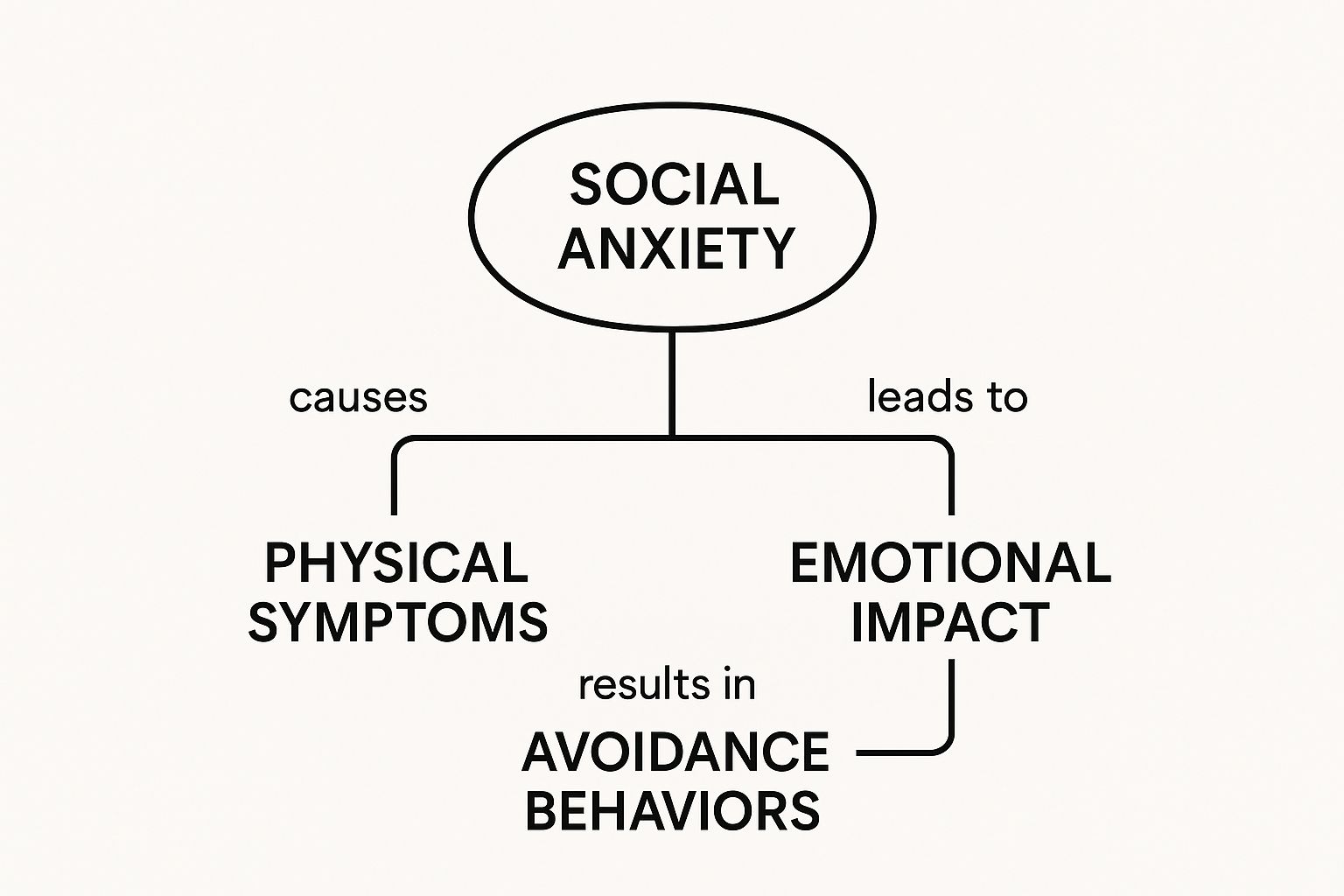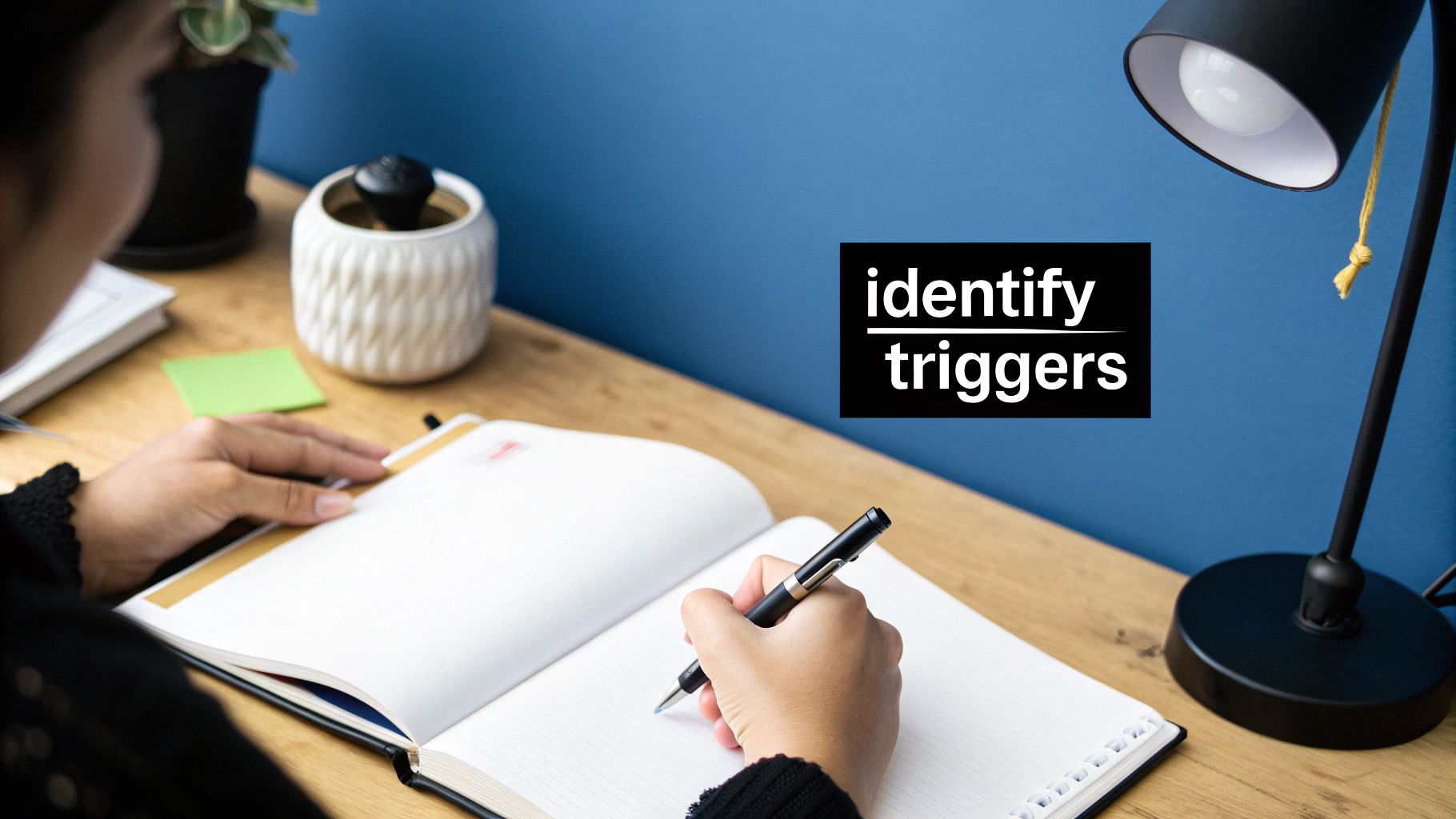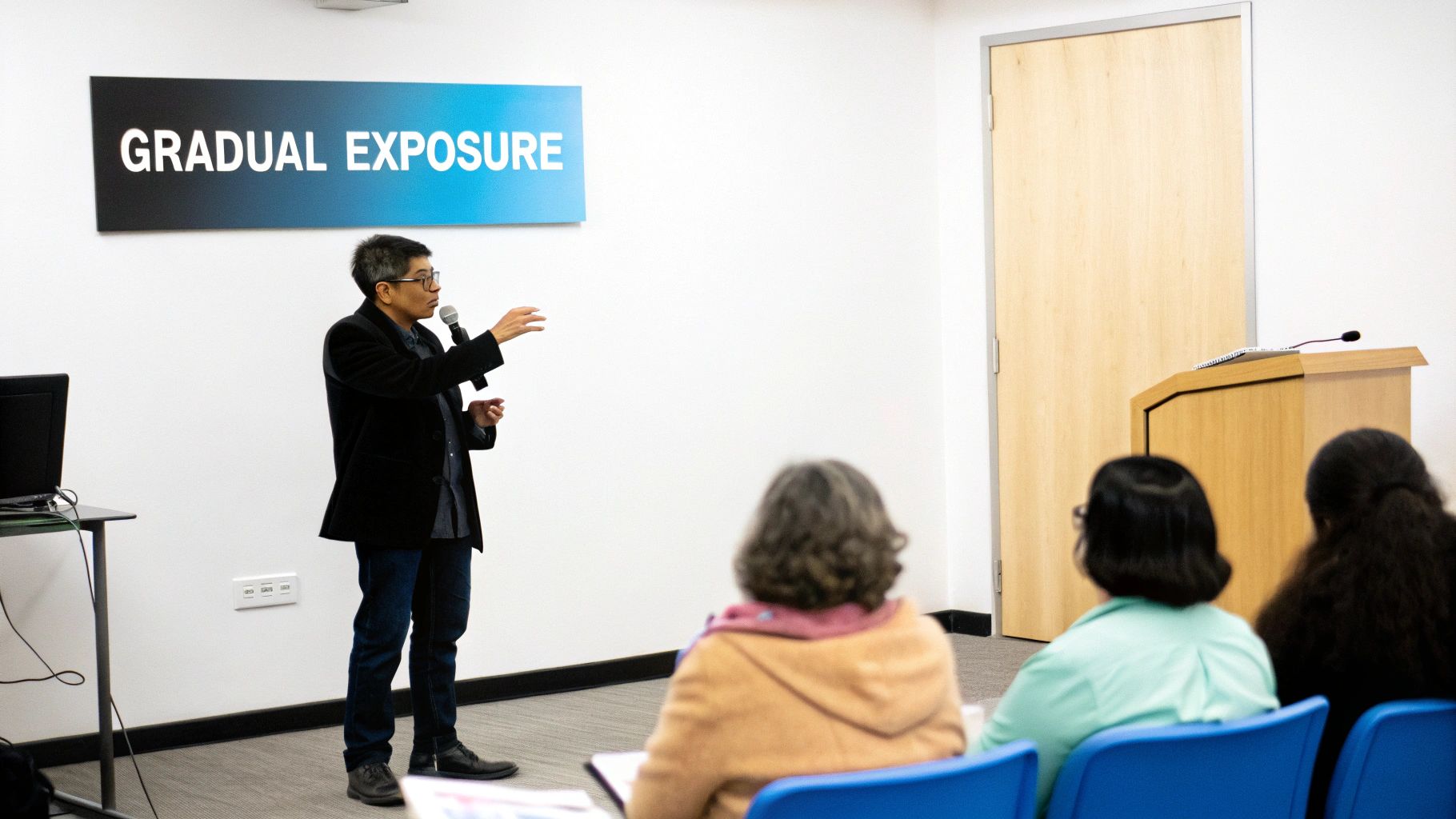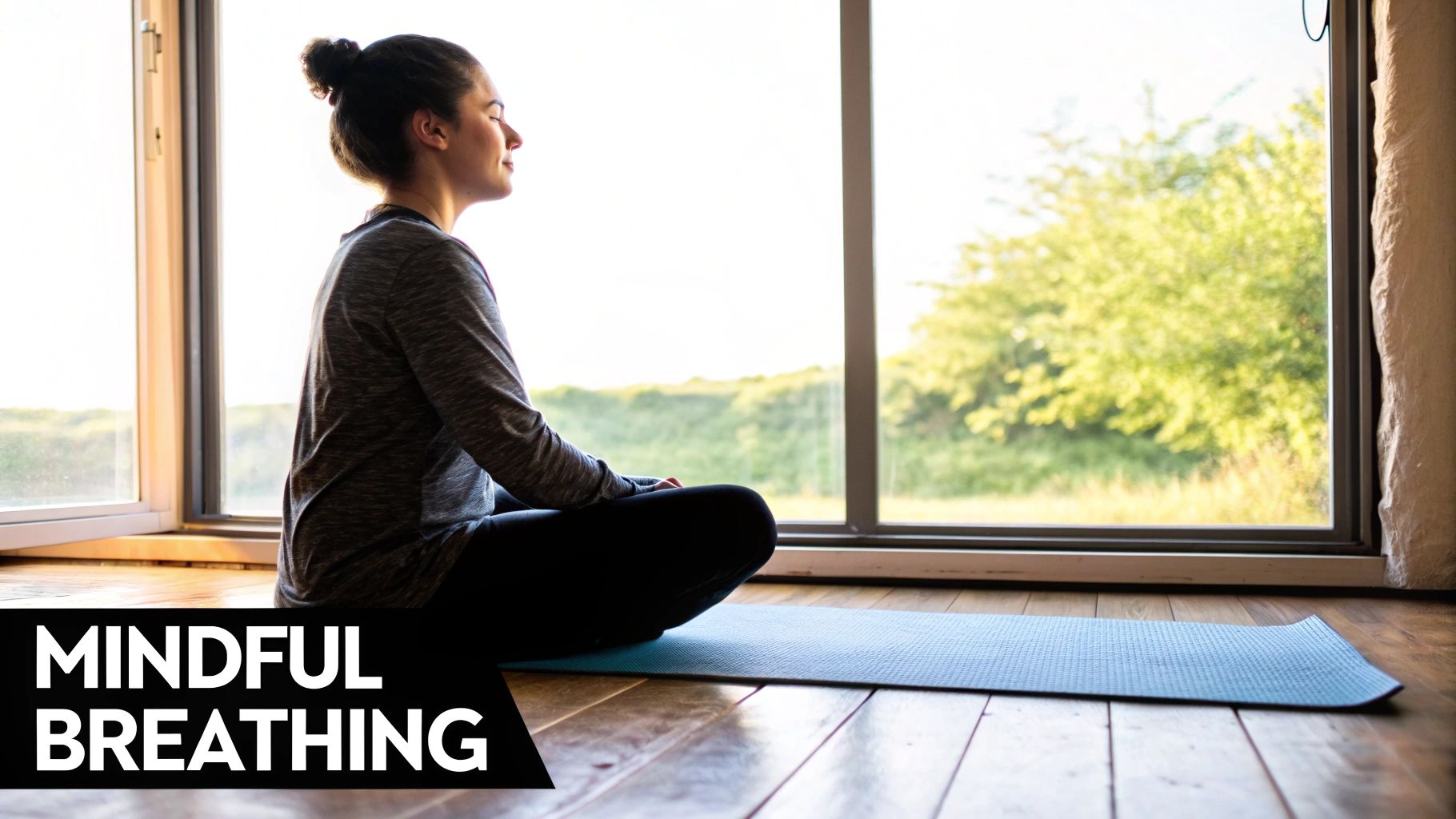Jan Elvis
07.10.2025

Jan Elvis
07.10.2025
Overcoming social anxiety isn't about flipping a switch and suddenly becoming an extrovert. It’s a process of untangling the fearful thoughts and ingrained behaviors that hold you back, so you can build real, lasting confidence in social settings. It's about taking practical steps, not just wishing you were less shy.
If you've ever dealt with social anxiety, you know it's so much more than just feeling nervous before a speech or being a little quiet at a party. It’s an intense, persistent fear of being watched, scrutinized, and judged by others.
This fear can be completely overwhelming. It can turn everyday interactions—like making a simple phone call, asking for help in a store, or even just eating in front of people—into massive, terrifying hurdles. It often comes with a harsh inner critic that’s constantly forecasting disaster, predicting you'll do or say something wrong and face humiliation.
To get a real handle on social anxiety, it helps to see it for what it is: a combination of physical sensations, emotional turmoil, and behavioral reactions that all feed off each other. It’s not just in your head.
This infographic lays out the core components and how they interact.

As you can see, it’s a vicious cycle. The physical symptoms (like a racing heart) trigger anxious thoughts, which then fuel the urge to avoid the situation altogether. And when you avoid it, you just reinforce the fear.
People often throw around the terms "social anxiety," "shyness," and "introversion" as if they mean the same thing, but they're worlds apart. Shyness is a personality trait involving discomfort around new people. Introversion is about how you recharge your energy—preferring quiet, solo time over constant social stimulation.
Social anxiety, on the other hand, is a clinical condition rooted in fear. It’s a fear-based response that can seriously get in the way of your life, from your career to your relationships. For a deeper dive into the specifics, this guide on understanding social anxiety disorder is a great resource.
Getting clear on these differences is the first real step toward finding the right solution. You can use the table below to see where your experience fits.
Use this table to see the key differences between these commonly confused traits and find clarity on your experience.
| Characteristic | Social Anxiety | Shyness | Introversion |
|---|---|---|---|
| Primary Driver | Intense fear of negative judgment, scrutiny, or humiliation. | Apprehension or discomfort in new social situations. | Preference for less stimulating environments; social energy is finite. |
| Impact on Life | Can be highly debilitating, leading to avoidance of school, work, or relationships. | Usually manageable and doesn't prevent participation in life activities. | A personality preference; does not cause distress or impairment. |
| Physical Symptoms | Often involves a strong physical response: sweating, trembling, nausea, rapid heartbeat. | Can include blushing or a faster heartbeat, but typically less severe. | None; it's about energy levels, not a fear response. |
| Cognitive Pattern | Persistent, negative self-talk and worry before, during, and after social events. | Self-consciousness, but thoughts are less intrusive or catastrophic. | Neutral thoughts; focused on managing social energy, not fear of judgment. |
Seeing these distinctions laid out can be a huge relief. It helps you recognize that you aren't just "awkward" or "antisocial"—you're dealing with a specific set of patterns that, with the right approach, can absolutely be changed.
The core of social anxiety isn't a lack of social skills, but rather a powerful fear that prevents you from using the skills you already have.
And if you're struggling with this, you are far from alone. One study found that over 36% of young adults met the criteria for social anxiety disorder, showing just how common this is. Recognizing that millions of others are navigating the same challenges can make the experience feel less isolating.
Once you know exactly what you’re up against, the path to overcoming it becomes much, much clearer.
If you have social anxiety, you know the voice. It's that relentless inner critic that narrates every social interaction, always predicting the worst-case scenario. It can turn a simple coffee date into a high-stakes performance where you're convinced you're going to bomb. This internal monologue feels incredibly real, but it’s almost never based in reality.

The first step toward quieting that voice is recognizing that these thoughts are just that—thoughts, not facts. Learning to manage social anxiety means putting on your detective hat and impartially sifting through the evidence for and against these fearful predictions.
Your anxious mind is sneaky. It uses a set of predictable tricks, often called cognitive distortions, to keep you stuck in a cycle of fear. Once you learn to spot them, you can start to disarm them.
Here are a few of the most common culprits you might recognize:
When you can put a name to these thought patterns, they lose a lot of their power. You start to see them for what they are: bad mental habits, not undeniable truths.
Challenging your thoughts isn't about forcing yourself into toxic positivity. It’s about cultivating a more realistic, balanced perspective that isn't dictated by fear.
This is a fundamental skill, but many people live with these damaging thought patterns for years before getting help. Social anxiety often starts to show up around age 13, yet an eye-opening 36% of people report having symptoms for a decade or more before ever seeking treatment. You can find more social anxiety statistics from the National Institute of Mental Health.
Once you’ve identified a distorted thought, it's time to put it on the stand. Cross-examine it. Your goal is to poke holes in its logic and find any evidence that contradicts it.
Next time an anxious thought pops into your head, ask yourself these questions:
Let's try it. Say your thought is, "Everyone at the meeting thought my idea was stupid." Challenge it. Did every single person react negatively? Or did a few people nod? Is it possible some were just quietly processing what you said? This kind of structured questioning shatters the automatic belief you have in that anxious thought.
Beyond just challenging thoughts as they happen, you can also explore other actionable steps to master your anxiety and boost performance in all sorts of situations.
When social anxiety has you in a chokehold, avoiding things feels like the only safe option. That wave of relief you get after turning down an invitation is real, but it’s a short-term fix. Over time, that avoidance actually feeds the fear, teaching your brain that social situations are genuine threats you have to escape. The only way to really dismantle that fear is to prove it wrong, one small, manageable step at a time.
This is the whole idea behind gradual exposure. It’s a deliberate, controlled way of facing the situations you dread, starting with the least scary and slowly working your way up. I like to think of it like learning to swim. You wouldn't jump into the deep end; you'd start by dipping your toes in, then maybe wading in up to your knees, building confidence along the way.
The first move is to map out your own "exposure ladder." This is just a list of social situations that make you anxious, ranked from "a little nervy" to "absolutely terrifying." It's crucial that this list is specific to you. What’s a small step for someone else might feel like a huge leap for you, and that’s perfectly okay.
For instance, a ladder might look something like this, starting with the easiest task:
The strategy here is to start at the bottom rung. You don't move up until you feel the anxiety at your current level start to fade. It's not about getting rid of the anxiety completely—it's about learning you can handle the discomfort until it passes on its own.
Progress isn't about never feeling anxious again. It's about not letting that feeling dictate your choices. Each small exposure is a vote of confidence in your ability to handle discomfort.
Got your ladder? Great. Now it’s time to take action.
Pick that first step, the one that only causes a slight flutter of anxiety. Before you do it, be clear about your goal. For example, "Today, when I get my coffee, I'm going to make eye contact with the barista and smile." The goal isn't to have a full-blown conversation; it's simply to hold eye contact. That’s it.
When you're doing it, try to stay in the moment. Notice the anxious thoughts and physical feelings without judging them. Your heart might pound. Your brain might start screaming, "You look so awkward!" Just let those feelings be there. Acknowledge them, but don't fight them. They’re temporary, and they will pass.
Afterward, take a second to reflect on what actually happened. Was it as bad as your anxiety predicted? Almost always, the reality is way less catastrophic than the disaster movie your mind played out beforehand. This realization is pure gold—it’s the evidence you need to show your anxiety it doesn't know what it's talking about.
Finally, give yourself credit. Acknowledge that you did something brave, no matter how tiny it seems. This little pat on the back reinforces the positive behavior and helps rewire your brain, slowly teaching it that social situations aren't life-or-death battles. It's this steady, step-by-step momentum that builds real, lasting confidence.
A huge part of social anxiety comes from that deer-in-the-headlights feeling—the paralyzing sense that you just don't know what to do or say. Let’s build a practical toolkit of skills that feel like you, not like you're playing a character. The goal isn't to become some fake, extroverted version of yourself, but to feel more grounded and capable in everyday social situations.

Often, it’s the fear of being judged that makes us turn the microscope on ourselves, analyzing every single move. By picking up a few simple techniques, you can flip that focus outward. This takes a ton of pressure off and makes any interaction feel way more manageable.
If you want one single tool to keep a conversation from dying, this is it: the open-ended question. These are simply questions that can't be answered with a "yes" or "no." They naturally invite the other person to share more, which means less conversational heavy lifting for you.
Think about it. Instead of asking, "Did you have a good weekend?" (which usually gets a one-word reply), try, "What did you get up to over the weekend?" That small tweak completely changes the dynamic.
Here’s a quick before-and-after:
| Closed Question (Avoid) | Open-Ended Question (Use) |
|---|---|
| "Do you like this music?" | "What kind of music have you been listening to lately?" |
| "Are you busy at work?" | "What's the most interesting project you're working on?" |
| "Was your trip fun?" | "What was the best part of your trip?" |
Asking questions like these gives the other person room to talk, which lets you relax, breathe, and just listen.
Active listening isn’t just about waiting for your turn to talk; it's about showing the other person they're being heard. This is a massive relief for social anxiety because it shifts your job from "performer" to "observer." Your primary goal becomes understanding them, not thinking up the perfect witty response.
When you're genuinely listening, follow-up questions just sort of happen naturally. Here’s how to get started:
The secret to being a good conversationalist isn't having the most interesting things to say—it's being the most interested in what others have to say.
Once you make this shift from performing to listening, everything changes. It’s a genuine game-changer.
Long before you say a single word, your body language is already talking. Making a few small, intentional adjustments can actually make you feel more confident while also making you seem more approachable. This creates a positive feedback loop.
Start with your posture. Just sitting or standing up straight sends a signal of confidence to your own brain. It sounds simple, but it works.
Also, don't underestimate how much your personal presentation affects your mindset. Taking a few extra minutes for self-care can be an incredible confidence booster. For some practical ideas, check out these great grooming tips for men that can help build that foundation of feeling good in your own skin. When you feel put-together on the outside, it’s so much easier to project self-assurance, making those social hurdles feel a lot smaller from the get-go.
Tackling social anxiety isn't just about what you do in the moment at a party or during a presentation. Real, lasting change comes from the foundation you build every single day. When you intentionally create habits that support your overall well-being, you lower your baseline stress. This makes you far more resilient when you face those social situations that used to send you spiraling.

This isn't about a massive, overnight life overhaul. It's about making small, sustainable shifts. You’re weaving simple practices into your routine that ground you in the present and fortify your mental health from the inside out.
Social anxiety loves to trap us in "what-if" thought loops about the future. Mindfulness is the antidote. It yanks your attention away from those future worries and plants you firmly back in the present moment, where things are usually okay.
Next time you feel that familiar wave of anxiety rising, try this discreet grounding exercise:
Just a few minutes of this a day can train your brain to step back from the frantic inner monologue that fuels social fear.
Building a calmer internal world makes navigating the external social world far less intimidating. Your daily habits are the bricks you use to build that inner fortress.
You can't separate your physical health from your mental state—they're deeply connected. What you eat, how much you move, and the quality of your sleep have a direct and powerful impact on your anxiety levels.
These lifestyle choices aren't just about being "healthy"; they are fundamental tools for managing your anxiety. Even small things, like your personal presentation, can have an outsized impact on your confidence. Taking a moment to learn how to smell good naturally can give you a subtle but powerful boost before you even walk out the door.
While these self-help strategies can be incredibly effective, there are times when getting some professional guidance is the best move you can make. If social anxiety is consistently getting in the way of your work, your education, or your relationships, it might be time to talk to a therapist.
It's an interesting side note that the need for support isn't the same everywhere. Research often shows higher rates of social anxiety in high-income countries, while people in lower-income regions can face huge barriers to getting help. A good therapist can give you a personalized roadmap with proven techniques like Cognitive Behavioral Therapy (CBT) to help you navigate your specific challenges and finally get some relief.
As you start working on your social anxiety, it's totally normal to have a ton of questions pop up. Feeling clear on what to expect can make the whole process feel less intimidating and give you the confidence to stick with it.
Let's tackle some of the most common things people wonder about.
This is the big one, right? The honest answer is: it's different for everyone. There’s no magic timeline. Your progress really depends on a few things, like where you're starting from, how consistently you practice things like gradual exposure, and if you’re working with a professional.
Some people notice a real shift in just a few weeks of focused effort. For others, it's a longer journey spanning several months. The key is to forget about some imaginary finish line and just focus on making steady progress. Seriously, celebrate every small win—that’s what builds momentum and keeps you going.
Yes, you absolutely can. Many, many people learn to manage and even overcome social anxiety using therapy, lifestyle changes, and the behavioral strategies we've talked about.
Techniques like Cognitive Behavioral Therapy (CBT) and the exposure exercises are proven to be incredibly effective on their own. While medication can be a useful tool, especially for more severe cases (often used alongside therapy), it's definitely not a requirement for making huge improvements.
If you're looking for one simple, powerful thing to do today, try this: gently question just one of your automatic anxious thoughts.
Let's say your brain's default is, "Everyone will think I'm boring." The next time you're in a social situation, challenge yourself to find one tiny piece of evidence that proves that thought wrong.
Did someone smile when you walked in? Did one person ask you a simple question about your weekend? This small act starts to poke holes in the story your inner critic tells you. It’s proof that you have the power to shift your perspective.
This single, manageable action can be the first crack in the foundation of your anxiety. It's a powerful reminder that you're more in control than you think. And speaking of feeling in control, we know the stress of it all can sometimes show on your face. You can learn more about tackling that in our guide on how to remove bags under eyes for men.
At Main Character, we believe that building confidence starts with your daily routine. Explore our collection of personal care products designed to help you feel your best from the inside out. Visit us at https://www.dontlooktrash.com.